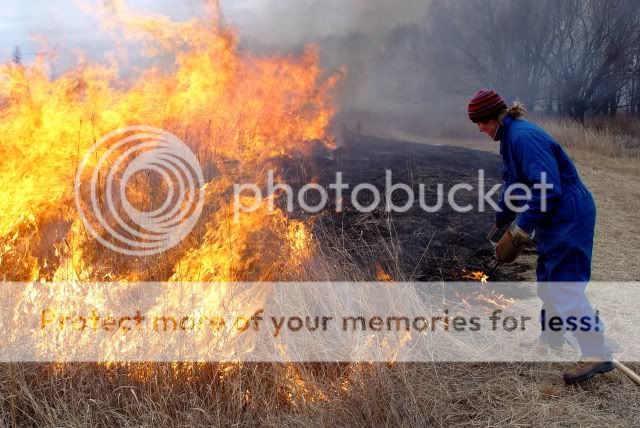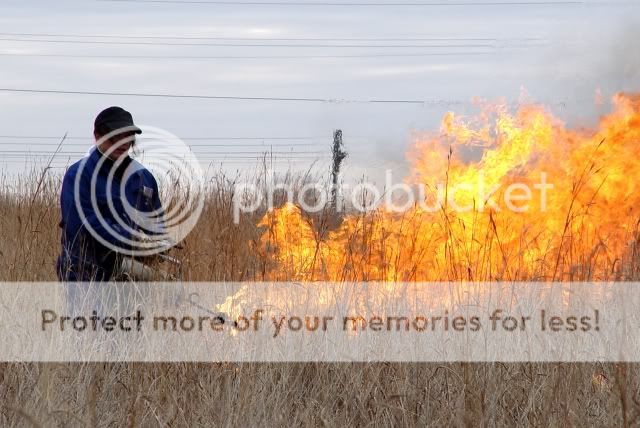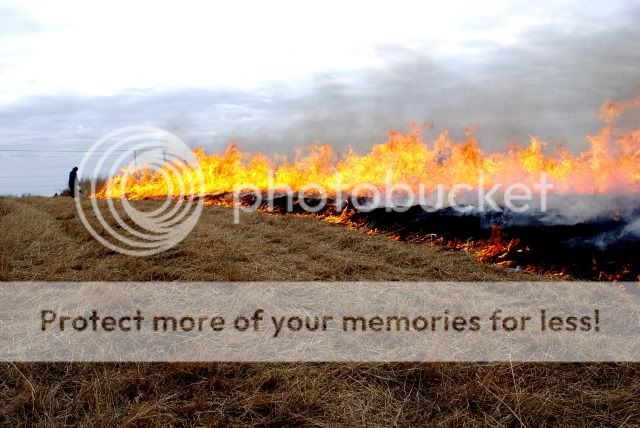Hey Leo, I know nothing about the ecology of Illinois's dune prairies, but I'd imagine the effect isn't that dire. In Florida (an area I have studied and actually been a participant in controlled burns) fires naturally occur in late spring and extend into mid summer, from May to July. In this case all the plants have already grown and have flower (or are in the process) and all the animals are active and many are raising their young. Except where fires got so hot that they crowned (burned the canopy trees), the result was always positive.
Areas that were overgrown with subcanopy hardwoods and shrubs were suddenly open grassland again, allowing herbaceous species to flower and reproduce. I can't tell you how many orchids "suddenly appeared" after a burn - usually the next spring - Calopogon species, Pogonia ophioglossoides, Cleistes bifaria and C. divaricata, Platentheras of all kinds, Spiranthes, and on down the line. The bigger problem in the states is fire suppression, not burns, at least in fire dependent communities. Mesic forest is a whole other matter.
It would be interesting to hear the Illinois park's department and DNR's view on this burn. Do you know if it was a prescribed burn or arson?
I don't know what the DNR or the park officially said. I did catch the newspaper and an earful from a neighbor who spends more time in the park than I do.
The burn was supposed to be a planned burn for 10 acres.
Only ten acres. The fires swept through at least 400 acres.
To the best of my understanding the volunteers who set the fire had obtained a permit. The permit was issued for a specific 10 acre site. The permit clearly states that the burn should be postponed if the winds are over 5 mph. I am guessing they did not check in with the Park headquarters immediately before the burn as the permit also requests. The winds were forecast for steady winds of 15 to 20 mph with gusts in excess of 30 mph, actual gusts that day reached 40 mph at times. It was visibly a blustery day, from sunrise to sunset. This wind did not blow up unexpected. It was irresponsible to start the fire that day. Total criminal negligence. The arrogance of the volunteers to think the rules did not apply to them and their prairie burn. It might be possible, because of the deliberate indifference to safety of people, property, and the prairie itself, to charge these prairie burning volunteers with arson, though that probably won't happen.
To the best of my knowledge Illinois Beach State Park is the only remaining remnant of the Great Lakes dune & sand prairie ecosystem left in the state of Illinois. There is a relatively narrow strip of this habitat, and that is all there is in IL, you either have to go 10 miles north into Wisconsin for a little patch there, then another 50 or so miles further north to a patch north of Milwaukee. Or 90 miles to the south where you have the Indiana Dunes complex. This entire region inbetween is densely developed as urban and suburban properties. Home & factories are adjacent to this park. A decommissioned nuclear power plant is in the center of the park. This is an isolated island of prairie & dune-land. Though the park is 22,000 acres, I'd say less than 3000 acres are prairie, maybe another 2000 acres are dune and beach, and the rest is savanna transitioning into mesic forest. There are 2 discrete prairies about 2 miles apart. They are separated by the nuclear plant. This fire was at the smaller north unit. It looks to me that this fire burned more than half of the north unit prairie.
About the timing and benefit of burning a prairie;
Illinois is mostly zone 5, with a considerably shorter and more compressed growing season that Florida. Timing for burns is of course quite different.
Back nearly a dozen years ago, over a pitcher of beer I had a long talk with Dr. Ron Panzer, an entomologist, I think today he is with the Northeastern IL Univ. Now I haven't read his most recent publications, but at the time, our discussion was about timing of prairie burns. It is important to remember that a prairie is dependent on its insect populations. Flowering plants evolved to take advantage of the insects, and depend on them for pollination. The concern was that late burns, particularly in small island prairie remnants, destroy the insect populations. IL Beach is a small island remnant surrounded entirely by fairly dense urban, industrial and suburban land use. With the unburned patches being small, the possibility exists that some of the insects, especially butterflies, moths, leaf hoppers and those that are very specific in their choice of host species can be completely eliminated by an overly large burn. Insects that have limited flight ability do not recolonize habitat miles away, they tend to move in shorter hops. If their host species don't exist within their natural range of movement, they will stay confined to that remnant island ecosystem. Suburban front lawns are not suitable habitat for the more specialized insects to use as a green highway. The urban and suburban environment surrounding the park essentially are a barrier to the insects as difficult to cross as a dry desert. That is why for small prairies in particular, it is important to keep burns small, and do them earlier in the year. This burn was late enough that the insects were already out and feeding. Yes, the prairie will look green in a few weeks. We may even see a lot of blooms, in part because the dead grasses are out of the way and it will be easier to see. But my fear is that there will be little or no seed produced by the plants requiring specialized pollinators. In particular, orchids, milkweeds and members of the Gentian family. There are others, but I am not that well read on prairies.
So the enthusiasm for burning prairies, particularly late season burns of small remnant prairies, I feel is misplaced. That fire could have waited for another day, or for that matter, another year. They did not have to burn that day. The prairie was in fairly good shape, waiting another year would not have seriously changed the quality of the prairie. But the volunteers threw safety aside because they felt they were on a mission, and they were so important that the safety rules did not apply to them. It did not have to get out of control.
I know some of you guys & gals like to set the torch to a prairie once in a while. Well, please be more cautious, you don't want it to get out of control. If conditions are not right, put it off for another day, even if it ends up being to try again the next year. Also, think about the insects, that bug you save may pollinate your favorite Calopogon.
To get an idea about the diversity of prairie insects, read Ron Panzer's article;
http://www.neiu.edu/~cwinsect/index.html
or google any of his other articles.


























































